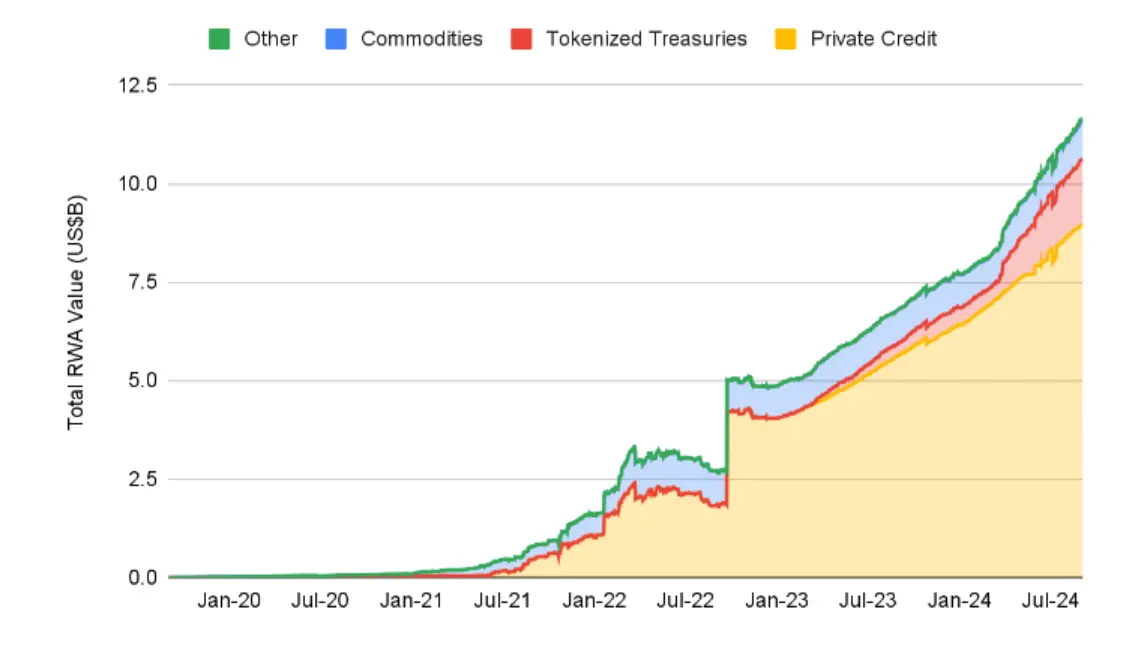A Comprehensive Interpretation of Binance's RWA Research Report: Traditional Institutions Actively Entering the Market, Asset Returns May Decline Under Interest Rate Cut Expectations
Author: Deep Tide TechFlow
The RWA sector has been quietly "making a fortune" during this atypical bull market.
When everyone's emotions are easily swayed by memes, a closer look at the data reveals that the tokens in the RWA track have likely outperformed most other sectors in terms of returns this year.

As U.S. Treasuries become the largest RWA, the trend of the sector being influenced by macroeconomic factors will become more apparent.
Recently, Binance Research released a long report titled “RWA: A Safe Haven for On-Chain Yields?”, which provides a detailed analysis of the landscape, projects, and performance of the RWA sector.
Deep Tide TechFlow has interpreted and distilled this report, with key content as follows.

Key Points
The total on-chain RWA has reached $12 billion, not including the $175 billion stablecoin market.
Major categories in the RWA field include tokenized U.S. Treasuries, private credit, commodities, stocks, real estate, and other non-U.S. bonds. Emerging categories include aviation rights, carbon credits, and artworks.
Institutions and traditional finance ("TradFi") are increasingly participating in RWA, with BlackRock's BUIDL tokenized Treasury product being the leader in this category (market cap > $500 million); Franklin Templeton's FBOXX is the second-largest tokenized Treasury product.
Six projects highlighted in the report: Ondo (structured finance), Open Eden (tokenized Treasuries), Pagge (tokenized, structured credit, aggregation), Parcl (synthetic real estate), Toucan (tokenized carbon credits), and Jiritsu (zero-knowledge tokenization).
Notable technical risks: centralization, third-party dependencies (especially for asset custody), oracle robustness, and whether the complexity of system design is worth the yield you obtain.
From a macroeconomic perspective, we are about to enter a historic interest rate cut cycle in the U.S., which may impact many RWA protocols, especially those focused on tokenized U.S. Treasuries .
RWA Data Fundamentals
Summary of RWA definitions: tokenized on-chain versions of tangible and intangible non-blockchain assets, such as currency, real estate, bonds, commodities, etc. A broader asset category includes stablecoins, government debt (mainly dominated by U.S. government bonds, i.e., Treasuries), stocks, and commodities.
The total on-chain RWA has reached a historic high of over $12 billion (excluding the over $175 billion stablecoin market)

Key Category 1: Tokenized Treasuries
Experienced explosive growth in 2024, increasing from $769 million at the beginning of the year to $2.2 billion in September.
Growth may be influenced by U.S. interest rates being at a 23-year high, with the federal funds target rate remaining stable at 5.25 - 5.5% since July 2023. This has made U.S. government-backed Treasury yields an investment tool for many investors.
Government endorsement -- U.S. Treasuries are widely regarded as one of the safest yield-bearing assets in the market, often referred to as "risk-free."
The Federal Reserve will initiate the interest rate cut cycle later this month at the September FOMC meeting, so it will be important to observe how RWA yields evolve as they begin to decline.

Key Category 2: On-Chain Private Credit
Definition: Debt financing provided by non-bank financial institutions, typically for small and medium-sized enterprises.
The IMF estimates that the market space for this in 2023 exceeds $2.1 trillion, with on-chain accounting for only about 0.4%, approximately $9 billion.
On-chain private credit is growing rapidly, with active loans increasing by about 56% over the past year.
The bulk of the growth comes from the Figure project, which offers credit lines secured by home equity.
Other major players in the on-chain private credit market include Mongolge, Maple, and Goldfinch.
Despite recent growth, the total active loans are still down about 57% compared to the same period last year. This aligns with the Federal Reserve's aggressive rate hikes, which have impacted many borrowers due to increased interest payments (especially as private credit loans often use floating rate agreements), leading to a corresponding decrease in active loans.

Key Category 3: Commodities (Gold)
The leading two tokens, Paxos Gold ($PAXG) and Tether Gold ($XAUT), hold about 98% market share in a market of approximately $970 million.
However, gold ETFs are very successful, with a market cap exceeding $110 billion. Investors remain reluctant to further increase their gold holdings on-chain.
Key Category 4: Bonds and Stocks
The market is relatively small, with a market cap of about $80 million.
Popular tokenized stocks include Coinbase, NVIDIA, and S&P 500 trackers (all issued by Backed).
Key Category 5: Real Estate, Clean Air Rights, etc.
Although it has not yet reached a level of widespread adoption, this category still exists.
The concept of renewable finance (ReFi) accompanies it, attempting to combine financial incentives with eco-friendly and sustainable outcomes, such as carbon emission tokenization.
Key Components of RWA
Smart Contracts:
Utilize token standards such as ERC 20, ERC 721, or ERC 1155 to create digital representations of off-chain assets.
A key feature is the automatic income accumulation mechanism, which allocates off-chain yields to on-chain. This is achieved through rebase tokens (like stETH) or non-rebase tokens (like wstETH).
Oracles:
Key trend: RWA-specific oracles. Legal compliance, accurate valuation, and regulatory oversight are issues that generalized oracles may not fully address.
For example, lenders in private credit may issue RWA mortgages on-chain. Without high-quality oracles to convey how funds are utilized, borrowers may not comply with loan agreements, incurring risks, and may even default.

(Image source: original report, compiled by Deep Tide TechFlow)
- Projects working on dedicated oracles: Chronicle Protocol, Chainlink, DIA, and Tellor.
Identity/Compliance
- Emerging technologies for identity verification, such as soulbound tokens ("SBT"), while zero-knowledge SBTs ("zkSBT") offer a promising method to verify identity while protecting sensitive user information.
Asset Custody
A combination of on-chain and off-chain solutions for management:
On-chain: secure multi-signature wallets or multi-party computation ("MPC") wallets for managing digital assets. Off-chain: traditional custodians holding physical assets comply with legal requirements to ensure proper ownership and transfer mechanisms.
Entry of Traditional Financial Institutions
BlackRock (AUM $10.5 trillion)
The U.S. Institutional Digital Liquidity Fund ("BUIDL") is the market leader, exceeding $510 million.
Launched only in late March, it quickly became the largest product in the field.
Securitize is a key partner for BlackRock in BUIDL, serving as the transfer agent, tokenization platform, and placement agent.
At the same time, BlackRock is the largest issuer of spot Bitcoin and spot Ethereum ETFs.
Franklin Templeton (AUM $1.5 trillion)
Their on-chain U.S. government money market fund ("FOBXX") is currently the second-largest tokenized Treasury product, with a market cap exceeding $440 million.
BlackRock's BUIDL operates on Ethereum, while FOBXX is very active on Stellar, Polygon, and Arbitrum.
The blockchain-integrated investment platform Benji adds more functionality to FOBXX, allowing users to browse tokenized securities while also investing in FOBXX.
WisdomTree Investments (AUM $110 billion)
- Originally a global ETF giant and asset management company, they have further launched multiple "digital funds." The total AUM for all these RWA products exceeds $23 million.
Project Analysis
The projects highlighted in the report include Ondo (structured finance), Open Eden (tokenized Treasuries), Pagge (tokenized, structured credit, aggregation), Parcl (synthetic real estate), Toucan (tokenized carbon credits), and Jiritsu (zero-knowledge tokenization).
The business models and technical implementations of each project are described in detail in the report, and due to space limitations, they are not elaborated here.
A comprehensive comparison and characteristics of each project are shown in the table below:

(Image source: original report, compiled by Deep Tide TechFlow)
Overall Results and Outlook
- RWA can generate yields, but whether the technical risks versus yields are worth it is subjective. The technical risks are as follows:
Centralization: Higher degrees of centralization are exhibited in smart contracts or overall architecture, which is unavoidable considering regulatory requirements.
Third-party dependencies: Heavy reliance on off-chain intermediaries, especially for asset custody.
- Some new technological trends:
The emergence of RWA-specific oracle protocols. Established companies like Chainlink are also increasingly focusing on tokenized assets.
Zero-knowledge technology is becoming a potential solution to balance regulatory compliance with user privacy and autonomy.
- Does RWA need its own chain?
Benefits: It would be easier to launch new protocols on these chains without establishing their own KYC framework and overcoming regulatory hurdles, thus promoting the growth of more RWA protocols; traditional institutions or Web2 companies wishing to adopt certain blockchain features can ensure all their users are KYC-compliant/meet necessary regulatory requirements.
Drawbacks: Facing "cold start" issues; difficult to guide liquidity to new chains and ensure sufficient economic security; higher barriers to entry, users may need to set up new wallets, learn new workflows, and familiarize themselves with new products.
- Outlook on the upcoming interest rate cut expectations
The market anticipates that the Federal Reserve will begin the interest rate cut cycle at its next meeting on September 18, which raises questions about what this means for RWA projects thriving in a high-interest-rate environment.
While yields on some RWA products may decline, they will continue to offer unique benefits such as diversification, transparency, and accessibility, which may continue to position them as attractive options in a low-interest-rate environment.
- Concerns about the legal environment
Many protocols still exhibit significant centralization, and various technologies, including zk, have considerable room for improvement.
Decentralization while maintaining regulatory compliance; this may also require some changes to traditional compliance systems to recognize new forms of verification.
Most RWA protocols still have a long way to go before genuinely reserving financial products for professional investors while achieving permissionless access.









